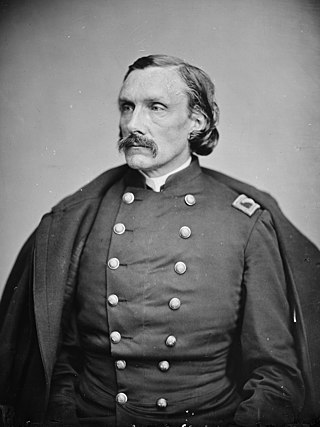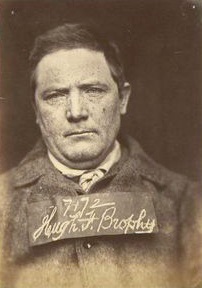
The Fenian Brotherhood was an Irish republican organisation founded in the United States in 1858 by John O'Mahony and Michael Doheny. It was a precursor to Clan na Gael, a sister organisation to the Irish Republican Brotherhood (IRB). Members were commonly known as "Fenians". O'Mahony, who was a Gaelic scholar, named his organisation after the Fianna, the legendary band of Irish warriors led by Fionn mac Cumhaill.

The Catalpa rescue was the escape, on 17–19 April 1876, of six Irish Fenian prisoners from the Convict Establishment, a British penal colony in Western Australia. They were taken on the convict ship Hougoumont to Fremantle, Western Australia, arriving 9 January 1868. In 1869, pardons had been issued to many of the imprisoned Fenians. Another round of pardons was issued in 1871, after which only a small group of "military" Fenians remained in Western Australia's penal system.

The Irish Republican Brotherhood was a secret oath-bound fraternal organisation dedicated to the establishment of an "independent democratic republic" in Ireland between 1858 and 1924. Its counterpart in the United States of America was initially the Fenian Brotherhood, but from the 1870s it was Clan na Gael. The members of both wings of the movement are often referred to as "Fenians". The IRB played an important role in the history of Ireland, as the chief advocate of republicanism during the campaign for Ireland's independence from the United Kingdom, successor to movements such as the United Irishmen of the 1790s and the Young Irelanders of the 1840s.

James Wilson or Séamas Mac Liammóir, was an Irish Fenian and soldier of India. In 1867 he was transported as a convict to Western Australia and later escaped during the Catalpa rescue.
Clan na Gael (CnG) (Irish: Clann na nGael, pronounced[ˈklˠaːn̪ˠn̪ˠəˈŋeːlˠ]; "family of the Gaels") is an Irish republican organization, founded in the United States in the late 19th and 20th centuries, successor to the Fenian Brotherhood and a sister organization to the Irish Republican Brotherhood.

John Boyle O'Reilly was an Irish poet, journalist, author and activist. As a youth in Ireland, he was a member of the Irish Republican Brotherhood, or Fenians, for which he was transported to Western Australia. After escaping to the United States, he became a prominent spokesperson for the Irish community and culture through his editorship of the Boston newspaper The Pilot, his prolific writing and his lecture tours.

Hougoumont was the last convict ship to transport convicts to Australia.

Thomas McCarthy Fennell was a Fenian political prisoner transported as a convict to Western Australia.
The following lists events that happened during 1868 in Australia.

Denis Bambrick Cashman was an Irish political prisoner and diarist who was transported to colonial Western Australia due to Fenianism and wrote of his experiences in a diary.

Charles Joseph Kickham was an Irish revolutionary, novelist, poet, journalist and one of the most prominent members of the Irish Republican Brotherhood.

John Francis O'Mahony was an Irish scholar and the founding member of the Fenian Brotherhood in the United States, sister organisation to the Irish Republican Brotherhood. Despite coming from a reasonably wealthy family and being well educated, the primary pursuit of O'Mahoney's life was that of Irish Independence from the United Kingdom, a calling that ultimately left him in poverty. O'Mahony fought in the Young Irelander Rebellion of 1848 as well as the US Civil War, and was involved organisationally in the Fenian Rising of 1867 in Ireland and the Fenian Raids on Canada.

Thomas Clarke Luby was an Irish revolutionary, author, journalist and one of the founding members of the Irish Republican Brotherhood.

The word Fenian served as an umbrella term for the Irish Republican Brotherhood (IRB) and their affiliate in the United States, the Fenian Brotherhood. They were secret political organisations in the late 19th and early 20th centuries dedicated to the establishment of an independent Irish Republic. In 1867 they sought to coordinate raids into Canada from the United States with a rising in Ireland. In the 1916 Easter Rising and the 1919–1921 Irish War of Independence, the IRB led the republican struggle.

Edward (Ned) Duffy was an Irish Fenian.
Hugh Francis Brophy was an Australian rules footballer who played with Fitzroy in the Victorian Football League (VFL).
Joseph Denis Nunan was an Irish born patriot and builder transported to Fremantle for wounding a policeman. He became an architect and building contractor involved in significant buildings in Perth, Fremantle and York. He never gave up his Fenian beliefs and died before he could return to Ireland.
St Mary's Primary School began life as a Roman Catholic co-educational primary day school with single-sex classes located in West Melbourne, Victoria, Australia. The school was part of the parish of St Mary Star of the Sea, West Melbourne.

Hugh Francis Brophy was a leading Fenian and staunch supporter of Irish independence. He was convicted for his part in a plot to overthrow British rule in Ireland and establish a republic, and was sentenced to penal servitude. This sentence was later commuted to transportation to Australia.

John Flood was an Irish revolutionary and convict exile, and later Australian newspaperman, mining secretary and politician.














